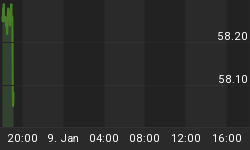Last month I visited Peru again, penetrating perhaps a bit deeper but certainly higher up in the Andes than I've gone before. No nose-bleeds, but I'm not ashamed to admit that scrambling over rocks in search of boiling textures at 5,300 meters (17,400 feet) elevation left me wheezing like Darth Vader.
But I found them, laying atop the gold zone at the silver project of one of the companies I came to Peru to look at. I've never seen boiling textures on such a large scale, but everything else at the project is big, so why not?

Cavities left by exceptionally large calcite crystals in a silicified vein outcropping - just the sort of thing you want to see when looking for veins containing precious metals. That's my lens cap in the photo. The crystals were inches long, instead of the usual millimeters or centimeters.
What it boils down to is that I like Peru better than ever.
I'm particularly pleased to see weakened support behind leftist firebrand Ollanta Humala in his second bid for the presidency. This was hard to quantify, especially while bouncing along in a jeep over "roads" that are little more than a pair of tire ruts carved into a cliff, while attempting to keep tally of the political signage. But I'm certain there were more campaign signs for candidates other than Humala, even in the rural provinces where he was strongest in the last election.

These lines are a typical Peruvian mountain road - I was not joking about the cliffs. The lighter lines are footpaths. Note the discoloration between the lower road and the upper switch-back. That's actually an old high-grade working.
The impression I gathered from numerous Peruvians I spoke with was that Humala is widely perceived as a negative for the country's economy, and that the leading candidates are genuinely pro-business (within a Latin American context, of course). Perhaps most important, the majority of the people of native descent I spoke with had only one thing on their minds: jobs.

These three gentlemen I came across on another company's project expressed no concerns about drilling, open pit mines, new roads, chemicals, etc. All they wanted was work. Note the green rocks scattered all around them. Those are copper oxides.
And no wonder, with so many people still living in mud-brick houses with no electricity.

These young girls live on the farm you see behind them, with no electricity and a nearby creek for water. When I see such things, I feel proud to be a part of the market's invisible hand, reaching out to help them with real jobs and training for their parents, not a government handout that keeps them dependent.
It's also a good sign when village elders smile and wave at passing company vehicles, rather than scowling. There are many more anecdotal positive signs, but they don't prove anything. My sense, however, is that the typical Peruvian knows the country has always benefitted from mining and wants to see it flourish, so long as it's done responsibly - and frankly, so long as those who are impacted see what's in it for them.
That's good, because the rocks in Peru are often spectacular and have been subjected to less exploration in recent decades than in many other places, leaving lots of potential for new discoveries.

Quartz, semi-massive and massive sulfide material, in a zone about 20 meters wide and several hundred meters long, with good grades of gold, silver, copper, lead, and zinc.
That's it in a nutshell. The economic numbers we reported in our more quantitative analysis last month jive with my personal evaluation on the ground. Along with Colombia and Chile, Peru is one of my favorite mining jurisdictions in South America, and I expect we'll see more opportunities to speculate on Peru plays in the near future.
Of the three companies Louis visited in Peru, he deemed only one fit for becoming the new silver pick for Casey's International Speculator at the time... a silver monster that subscribers immediately benefitted from owning, up 23.7% in the first month. Learn more about how Louis' boots-on-the-ground approach has been yielding amazing stock winners - click here.















